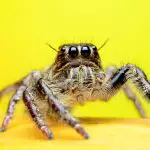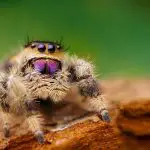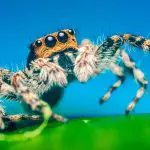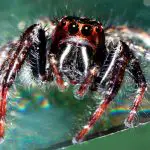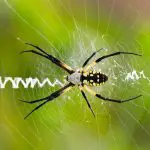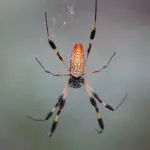Last updated on May 3rd, 2023 at 02:00 pm
Jumping spiders are smart – very smart! In fact, these spiders are thought to be the smartest arachnids of all. Some species even specialise in hunting other spiders because they are so much smarter than them. In addition to higher intelligence, jumping spiders also have great eyesight and – as you might have guessed – excellent jumping ability.

Jumping spider features
Large eyes, jumping nature, and unique web-building characteristics make the large group of jumping spiders different from the regular web-building spiders. These spiders belong to the family Salticidae.
There are more than five thousand species of jumping spiders. Some species of these tiny arachnids are more colorful than others.
The diverse bunch of these spider species shares a few things in common. They are mostly small, have fuzzy hairy bodies, eight eyes, excellent vision, and remarkable cognitive abilities.
With a brain that’s the size of a poppy seed, jumping spiders can prey on spiders and other insects more than double their size.
They are not orb weavers and are active throughout the day hunting their prey. However, these spider species make a nocturnal nest for resting.
Different species of jumping spiders vary widely in appearance. However, the big eyes, distinct look, and peculiar jumping movement give a general idea helping to differentiate them from other spiders.
Some of the most common jumping spiders are –
- Phidippus audax (Bold jumping spider)
- Phidippus regius (Regal jumper)
- Paraphidippus aurantius (Emerald jumping spider)
- Salticus scenicus (Zebra Jumper)
- Platycryptus undatus (Tan jumping spider)
- Menemerus bivittatus (Gray Wall Jumper)
- Attulus fasciger (Asian wall jumping spider)
If you’d like to try to observe some of them in the wild, check out the following products:
Are jumping spiders smarter than tarantulas?
Tarantulas are fascinating creatures and are often kept as exotic pets due to their low maintenance and requirement of less space to survive.
However, tarantulas are not considered particularly intelligent. More than their intelligence, tarantulas use their natural instincts for survival.
Natural behavior in the wild plus laboratory experiments reveals that jumping spiders are way more intelligent compared to tarantulas. Even for small things like approaching the prey and attacking them, jumping spiders reflect highly intelligent behavior.
Which spiders are most intelligent?
Intelligence and complex behaviors in animals are often associated with the size of the brain. However, for jumping spiders from the genus Portia, it’s a different story. Small but smart, these adorable creatures show an unbelievable level of brainpower.
These spiders are self-aware and can use the right combination of hunting strategies as different situations demand. When attacking web-building spiders, these small creatures with a tiny brain size, diligently plan out an effective route to reach their prey without alerting them.
Certain species of jumping spiders also hunt each other. They plan and play mind games to entice and attack their prey.
Predator male spiders approach a female’s nest on dead leaves and perform a mating dance that mimics the female’s actual mating partner. When the female comes out of the nest it is strategically killed and devoured.
Among the spider diversity, the notorious Black widow spiders from the genus Latrodectus also exhibit a considerable degree of intelligence.
Black widows show patience as they sit and wait for their prey. A new study indicates that they can remember and have a good memory.
Ghost spiders, with smaller eyes, have a special ability to associate certain smells. They use this unique power to find their prey.
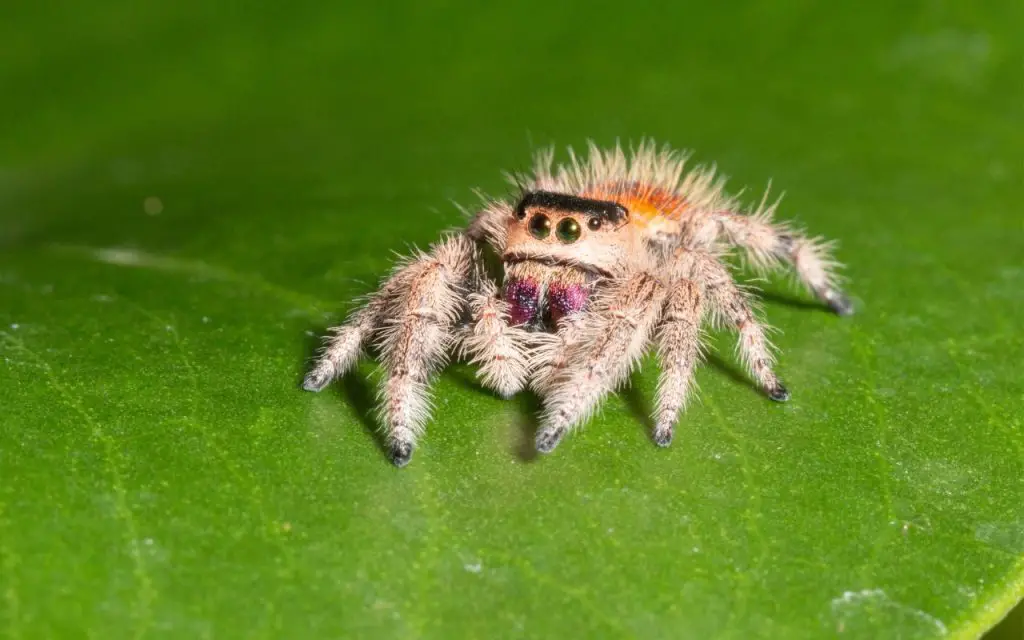
Are jumping spiders friendly?
Yes, jumping spiders are shy but friendly! They are observant and curious and watch everything closely before moving out of their hideouts.
These spiders may not like direct contact but are least aggressive when approached by humans. They are sociable, and their adorable jumping movements make them rather likable, unlike most web-building spiders.
Smartest spider
Among all the jumping spiders, Portia fimbriata also commonly known as the Fringed jumping spider is considered the world’s most intelligent spider. An ace hunter, the Portia spider changes its hunting strategy depending on the type of prey and the situation.
These highly intelligent spiders with heightened visual capacity also perform elaborate courtship dances to allure their potential mates. These among other Portia’s tricks help them to hunt their prey and survive predators.
A jumping spider can be called a spider hunter. Most jumping spiders feed on both spiders and insects that are often larger than them.
Jumping spiders are known to use more than five different plucking methods to check the state of webs, locate, and catch their prey.
Why are jumping spiders so intelligent?
Jumping spiders negate the general idea that some kind of a critical mass of brain tissue is required for performing complex behaviors. Tiny spider brains of these small things surprise scientists with their sophisticated behavior.
One reason for their behaviorally advanced manner is their sharp vision. With a body length as tiny as 1 millimeter to 2.3 centimeters, they have considerably big eyes.
Among the four pairs, three pairs are secondary eyes that are fixed. Only the main pair of eyes is movable.
It’s their visual prowess that helps them find, stalk and attack their prey effectively. Jumping spiders are well-known for their web-building strategy which is mainly constructed for resting.
Jumping spiders can jump to a great distance compared to their body size. Jumping spiders do not have special leg muscles like grasshoppers.
With non-muscular legs, they do not rely on muscle strength to make leaps almost fifty times their body’s length.
These spiders have the capability of rapidly increasing the blood flow in their legs garnering pressure. That results in extended legs which in turn help them to propel their bodies and travel a distance through the air.
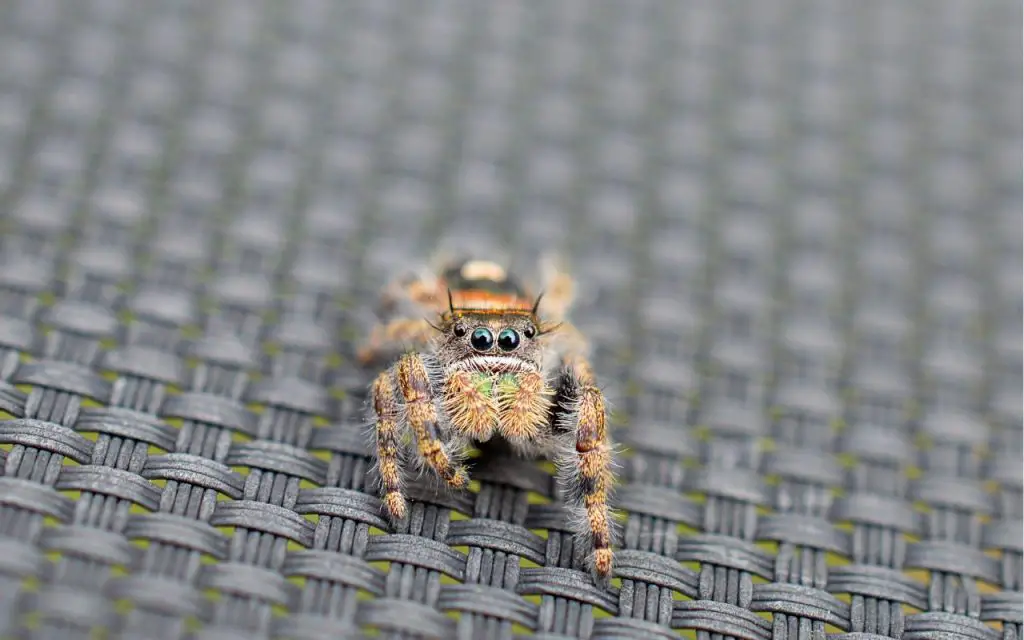
Do spiders think?
Can spiders think like humans? Maybe not, but they reflect hidden cognitive abilities with their complex learning behavior, foresightedness, and strategic planning.
Over the centuries scientists have wondered about the intellectual capabilities of spiders and new scientific studies reveal a lot about spider brains and their cognitive abilities. Most spiders with poor eyesight sense their surroundings mostly through scents and vibrations.
Jumping spiders like the Portia, display a greater level of problem-solving ability compared to creatures of the same size. This species of spider has been successfully trained to perform tricks like jumping on command and running mazes.
However, no spider has the thinking ability that can match even the smallest mammals.
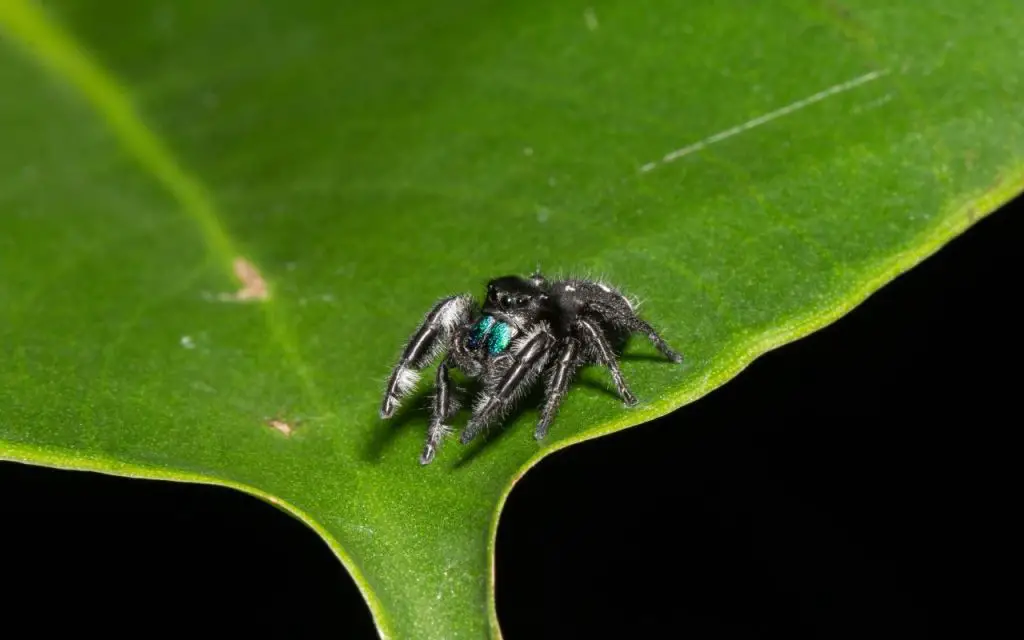
Are jumping spiders poisonous?
Jumping spiders are technically poisonous. Their venom mostly paralyzes the prey but is harmless for humans.
When sensing the danger of being attacked, jumping spiders may spit out a significantly small amount of venom to neutralize the enemy. It is a self-defense mechanism that keeps the spiders safe from their potential enemies and helps in killing their prey.
Jumping spider bites are not painful and mostly do not result in rashes or irritation.

Are jumping spiders good to have around the house?
Unlike most spiders, jumping spiders look adorable with their big eyes and agile movement. They are good to have inside the house and outdoors in the garden as they prey on other spiders and insects.
They can be an excellent means of natural pest control. These arachnids are carnivores. Jumping spiders feed on other spiders, silverfish, flies, moths, and small defenseless insects.
Jumping spiders are different from other web-building spiders.
This particular web spider constructs webs that mainly serve the purpose of resting at night. So, with these tiny things jumping around the house, you will not have to clean up messy and sticky cobwebs.
Jumping spiders have a spunky personality. They are alert, non-poisonous, and shy, yet their curiosity makes them come closer to humans.
Jumping spiders are also good to have in the garden as they also devour juicy insect eggs. That keeps garden pests under control.
These common house guests are beneficial compared to any other spiders in the neighborhood. The mildly venomous spiders are peaceful and never bite unless threatened or provoked.
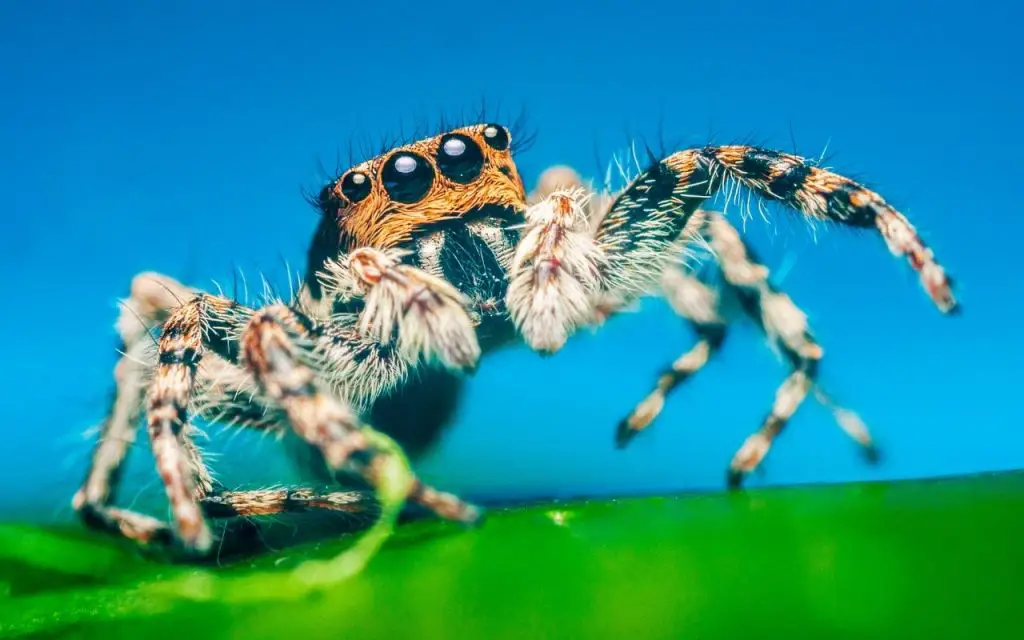
FAQ relating to if jumping spiders are smart
Do jumping spiders have intelligence?
Considering the tiny brain size of a sesame seed of these arachnids, jumping spiders possess a high level of intelligence. They outsmart their prey with planned detours and calculated moves.
Their sharp eyesight allows them to do tasks that are practically impossible for other creatures of their size to perform. These tiny creatures can think and adapt before they act.
Do jumping spiders have memory?
New studies suggest that jumping spiders possess an abstract working memory. This ability is mostly seen in bigger animals with a larger brain size.
In scientific experiments, jumping spiders have successfully navigated obstacle courses developed by scientists. Jumping spiders also remember the position of their prey once they spot it.
However, they may not remember faces or think about taking revenge if someone tried to harm them. Spiders only remember things that are important for their survival.
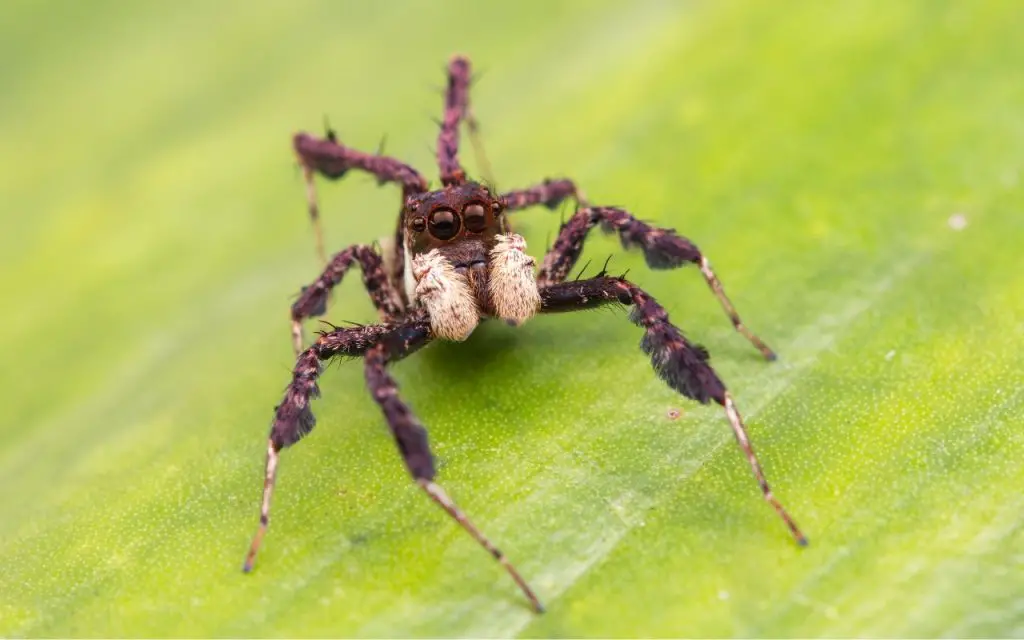
Why do jumping spiders seem intelligent?
The world of spiders is different from the human world. What’s graded as intelligence for humans is not exactly what one should look for while looking at spider intellect.
Jumping spiders seem intelligent due to their impressive, behaviorally advanced moves like clever hunting maneuvers, observant nature, and curiosity to discover their surroundings.
Scientific studies have revealed that these tiny arachnids may show REM sleep-like behavior. Do they dream like humans? That is yet to be discovered.

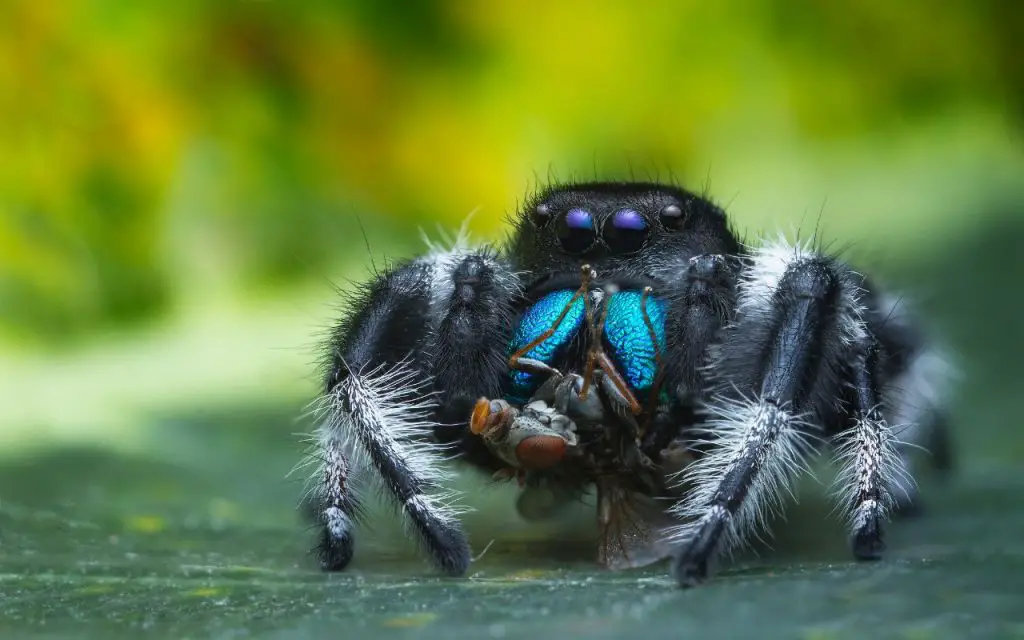
 Zilla Micro Habitat terrarium
Zilla Micro Habitat terrarium Jumping spider pet owners guide
Jumping spider pet owners guide Repti Zoo Acrylic Terrarium
Repti Zoo Acrylic Terrarium
